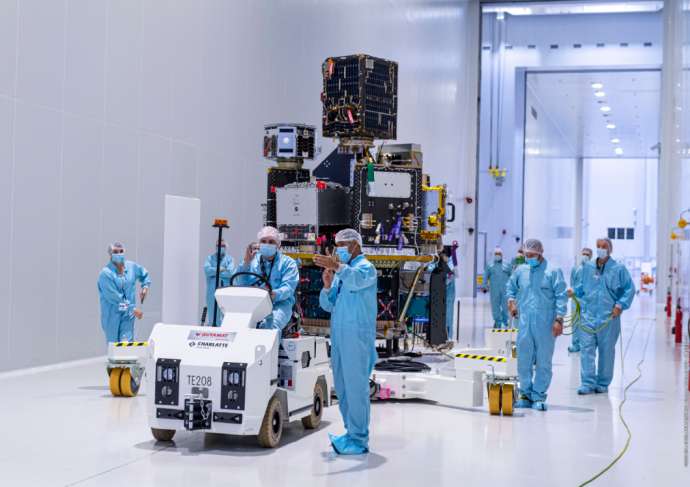STA, 3 September 2020 - Following a number of cancellations due to poor weather, the launch of Slovenia's first satellites, Trisat and Nemo HD, as part of a project by the European space company Arianespace, was successfully executed this morning.
Arianespace's Vega rocket, which carried a record 53 satellites from 13 countries, was successfully launched from French Guiana at 3:51am CET.
Both Slovenian satellites, which are an important milestone for the country's as well as European space technology efforts, have already been placed in the orbit, with Nemo HD circulating at 515 kilometres and Trisat at 530 kilometres above Earth.
Their first contacts with stations in Ljubljana and Maribor are expected to be established at 10:43am and 10:50am, respectively.
The head of the Trisat project Iztok Kramberger of the Maribor Faculty of Electrical Engineering and Computer Science told the STA a group of researchers had gathered at the faculty to follow the launch that had gone very smoothly.
"We're happy that this first hurdle is beaten. But now the real work only starts, we're only at the beginning," Kramberger said about the 4.4 kilo nanosatellite that is capable of taking multispectral images of Earth in short-wave infrared spectrum with a camera unlike any other in space at the moment.
It will primarily bring insights about how robust this new space technology is, while its images could help monitor things like sea pollution with oil stains or plastics, major fires or volcanic ash in the atmosphere for the needs of the aviation industry.
The Nemo HD is a 65-kilo micro-satellite, which will be producing panchromatic and multispectral images and will be able to do so in an interactive fashion.
It was developed by the Ljubljana-based Centre of Excellence for Space Sciences and Technologies (SPACE-SI) and will for instance help monitor the Earth for agricultural, forestry, urbanistic and maritime transport purposes.
The Slovenian satellites are part of the first test of the Small Spacecraft Mission Service (SSMS) concept, which will allow larger number of satellites to be deployed in one go, meaning at a smaller cost.
Kramberger spoke of a confirmation that Slovenia focused on the right size and technology and "caught the right development wave".
SPACE-SI head Tomaž Rodič agrees: "It is above all a confirmation that our development strategy in the field of micro-satellites, drawn up over a decade ago, was right and allowed us to be part of a pioneering mission of the European Space Agency."
Amsterdam-based Slovenian astrophysicist Jure Japelj echoed this view as well, stressing that Trisat was built almost exclusively in Slovenia.
"Foreigners can notice this and in time this leads to bigger projects," said Japelj, while explaining the primary focus of the two satellites would for now be the testing of new technologies.
A response has also come from Minister of Economic Development and Technology Zdravko Počivalšek, who tweeted that "Slovenia has joined the group of countries with operative satellites in space, a top achievement that should make us extremely proud".
The Education, Science and Sport Ministry later joined the ministry in a statement welcoming the "exceptional success and achievement the launch of the satellites represent in the field of science and research."
President Borut Pahor also congratulated the Trisat team project and SPACE-SI for developing Nemo HD, "which has taken Slovenian scientific excellence to the stars".
The University of Maribor and SPACE-SI have confirmed that contacts had already been established with Nemo HD and Trisat, with both at around 10.45am.
The computer on Nemo HD is already up and running, while sensors are expected to be launched and calibrated in the course of three months, followed by technological demonstrations.
On Trisat, the first things to be checked are the status of batteries, solar panels, and later on, two-way communication and launch of the computer will be attempted. It could become fully operational in less than three months.
The University of Maribor added it was proud that the launch had finally been successful after more than a decade of development, and noted that the launch of a new satellite was planed for next year.
"The dream is not over. This is only a beginning," Kramberger told the press, with University Chancellor Zdravko Kačič adding that "it is a historic day ... with Slovenia becoming one of the countries capable of managing hi-tech which enables the launch of a satellite."
According to Kačič, the launch of the two satellites is an important step in the internationalisation of Slovenia's space industry, promotion of space engineering and encouraging international cooperation.







